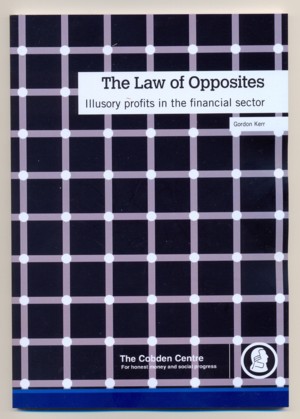This afternoon I attended an event in the House of Commons organised by the Adam Smith Institute, to launch their publication (published in partnership with the Cobden Centre) entitled The Law of Opposites: Illusory profits in the financial sector, by Gordon Kerr. Kerr himself spoke.
Alas, Gordon Kerr is a rather quiet speaker, and he did not use a microphone. Worse, after the talk had begun, I realised that right there next to me was some kind of air conditioning machine whirring away, in a way that made following Kerr’s talk difficult. Live and learn.
But I got the rough idea. Bad accountancy rules make disastrously unprofitable banks seem like triumphantly profitable banks, and those presiding over these banks are paid accordingly, even as their banks crash around them. And much more. The ASI’s Blog Editor offers further detail.
Good news though. I, like everyone else present, was given a free copy of The Law of Opposites. See if you can spot why I am reproducing the cover here. I am sure this will not take you long. I was interested to see if the effect in question would survive my rather primitive scanning skills. It does:

This publication is quite short, less than a hundred pages in length. Even better news. You don’t have to buy a paper copy like the one I now possess if you don’t want to. You can read the whole thing on line.




Brilliant. Thankyou Brian Micklethwait.
Have downloaded and am reading a .PDF copy of this educational book.
I had seen the spotty illusion before – its a classic perception trick. Good use for a book about illusory financial accounting and rule gaming.
I’m suing you! You’ve turned me into a lawyer! I see white as black, and black as white!
Banks and other financial institutions are inherently difficult things to value (and consequently, to calculate profitability for). For most businesses it is easy to separate the operations of the business (making widgets, or whatever it is that the company does) from capital raising (borrowing, equity raising, and other activities with financial instruments). However, in the case of a bank, borrowing, lending, and the like are the operations of the business, but capital raising must still occur. It is very easy to blur these things together in the case of a bank, and once you do, it can be very hard to tell what is going on, or very easy to lie about it, depending on your inclination.
Good God, what a weird effect.
Basically the only real profits that the big banks are making are by borrowing money from Central Banks and then lending it back to governments (at a higher rate of interest).
Everything else is just smoke and mirrors. Magic spells – not a real business.
Of course borrowing (newly created) money and then lending it back to (a different part of) the government that created it, is hardly a sustainable business model either.
OK, I’ll admit that I am not sure what the optical effect people are talking about is meant to be.
I see a grid of grey lines on a black background with white dots at the intersections. Some of the white dots, when seen from the corner of my eye, seem to be black dots with a white border. But when you look at them straight on they seem white again. Is that it?
Natalie: The illusion is that black is white.